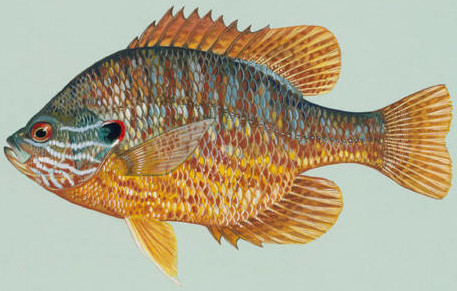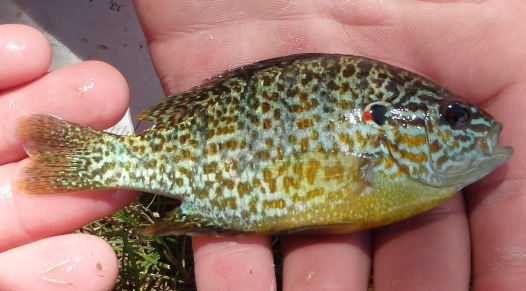Pumpkinseed (Lepomis gibbosus)


The pumpkinseed is a freshwater fish in both the sunfish family Centrarchidae and the true sunfish genus Lepomis. Centrarchidae meaning thorn / sting anus, referring to the presence of spines on the anal fin. Lepomis meaning scaled lid / cover, referring to their signature operculum. The pumpkinseed has a characteristic red dot on the opercular flap. Gibbosus meaning humpbacked or rounded, although in the case of the pumpkinseed not noticeably more so than other sunfish.
Where to Find Pumpkinseed
The native range consists of northern areas of the northeast quadrant of the USA. Now found throughout North America due to introductions and stocking, but not nearly as prevalent as bluegill. Prefer shallow and quiet waters of lakes and rivers.
Pumpkinseed can be found throughout the entire water column but for the plurality of the year associated with shallow water. In late spring to summer, they can be found in shallow water spawning grounds as shallow as 1 foot deep. They favor shallower water and more dense submerged aquatic vegetation than bluegills. Can at times be found at depths of 15-30 ft if sharp dropoffs are found near their preferred habitat.
Other Names for Pumpkinseed
Other names people have used to refer to this fish include common sunfish, sunny, yellow sunfish, bream, and kivver.
When to Fish for Pumpkinseed
Can be fished for all year long. Most productive times are when water temps are > 50F. Late spring to summer usually found near shallow water spawning areas. In winter can be taken through the ice or open water.
Diet of Pumpkinseed
Pumpkinseed are omnivores and opportunistic. They can feed in open water, in benthic areas, and on structure. They have a wide variety of possible food sources and local diets will vary by waterbody and seasonal availability. They have small mouths and specialize in suction feeding like a bluegill.
Pumpkinseed sunfish can eat anything a bluegill can but have traits suited for eating harder prey than bluegill. The pharyngeal teeth of pumpkinseed are well suited for crushing snails in comparison to the bluegill's which is better suited for softer prey. As such, a pumpkinseeds diet can be a majority of snails and freshwater mussels while a bluegill in the same waters will eat much less.
More examples of possible food items include chironomids (lake flies), molluscs, isopods, amphipods, caddisflies, and shadflies. While they can consume aquatic plants and algae, it hasn't been documented as a large part of their diet in comparison to some bluegill populations.
- Common Less than half pound
- Trophy 0.5 lb plus
- Record 0.75 lb plus
What Tackle to Use for Pumpkinseed
Tackle selection for pumpkinseed is the same as bluegill. Pumpkinseed will readily take to most styles of lures or baits. The most common mistake when selecting tackle for pumpkinseed is to use something too big. Hook size 10 to 8 is preferable, 6 if you are just looking for jumbos, 12 and below if you only have small / stunted sized population.
Aberdeen hooks are a popular hook choice for pumpkinseed. However, it should be noted that pumpkinseed can swallow hooks pretty easily and an aberdeen doesn't help reduce that risk. For wire size for pumpkinseed, light wire aberdeen or standard wire aberdeen will both fish well. Going with the light wire will help reduce damage to fish while fighting it and can be expelled from the fish more easily if they swallow the hook. For Eagle Claw 214EL hooks, size 8 is the smaller size to start with and then upsize to size 6 or 4 if needed. If you are fishing for micros or very small pumpkinseed the size 10 will also work.
Recommended lure and jig head is the Trout Magnet or, if only smaller fish present, the Mini Magnet.
Recommended artificial baits: Crappie Nibbles, Honey Worms, Floating Trout Worm, or Angle Worms
Recommended grocery store baits: corn, bread or marshmallows.
- Common Less than 6 inches
- Trophy 8 inches plus
- Record 9 inches plus
Cooking and Eating Pumpkinseed
Pumpkinseed are a good eating fish and they are very similar to bluegill in terms of eating, taste, and cooking. Anything you have read about cooking or eating bluegill should also apply for pumpkinseed. The fan favorite way to cook them is to fry them whole and enjoy them like you would fried chicken. If you fry them whole, the fins and smaller bones can also be eaten and provide a satisfying crunch. Pumpkinseed can also be filleted and you can cook the boneless portions of meat however you wish. However, given that pumpkinseed tend to be on the smaller side and due to their body shape, filleting can waste a lot of meat.
